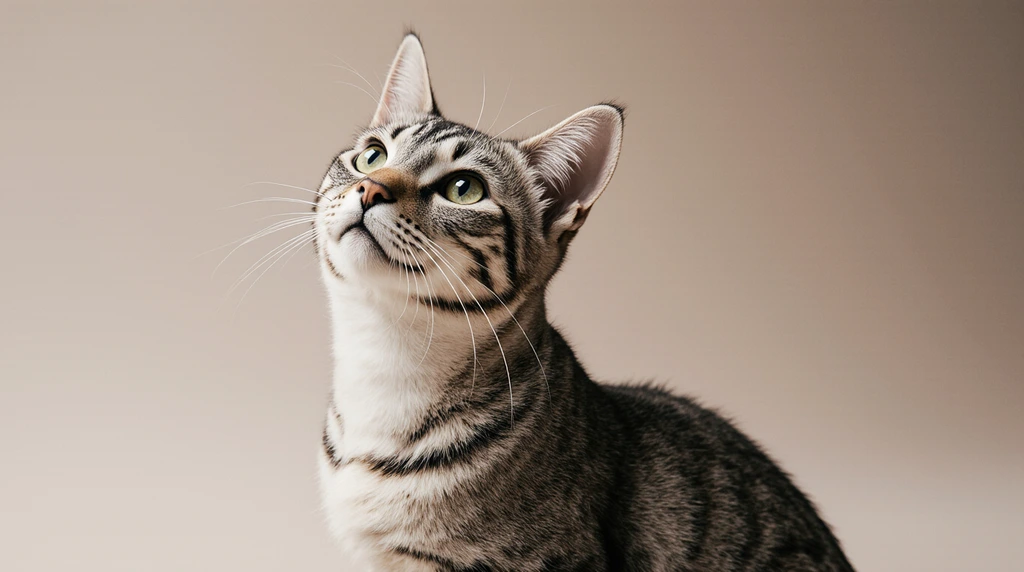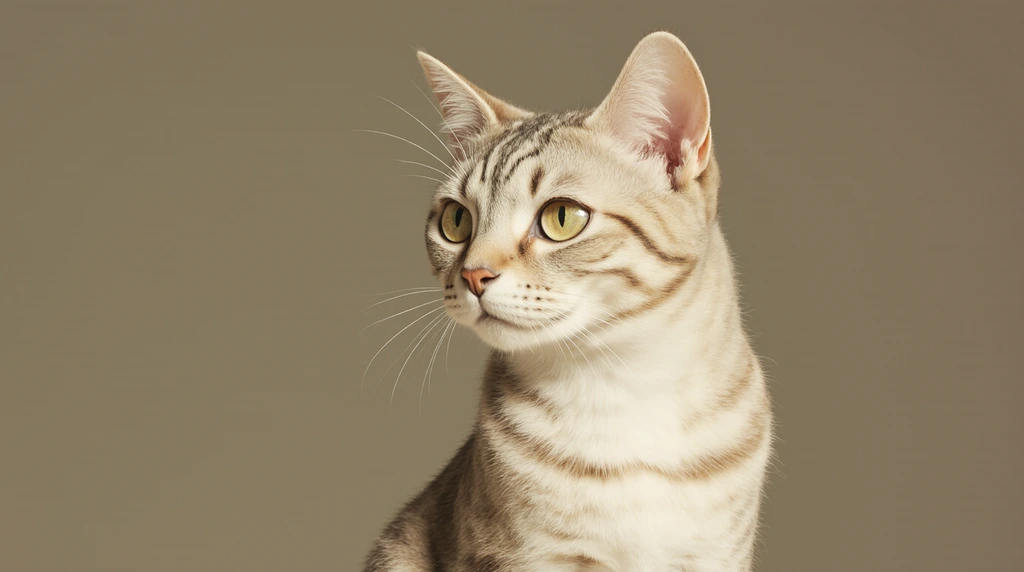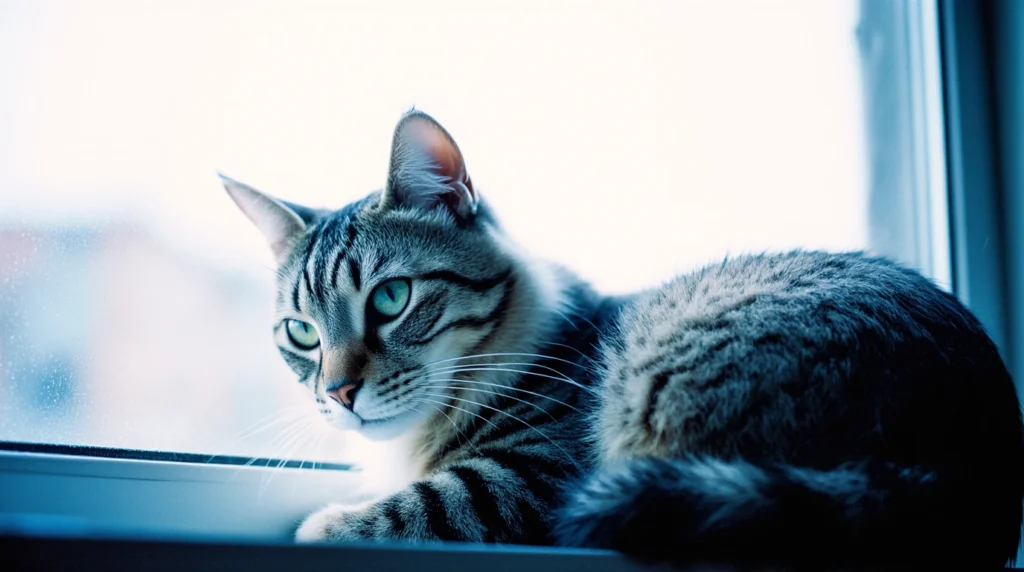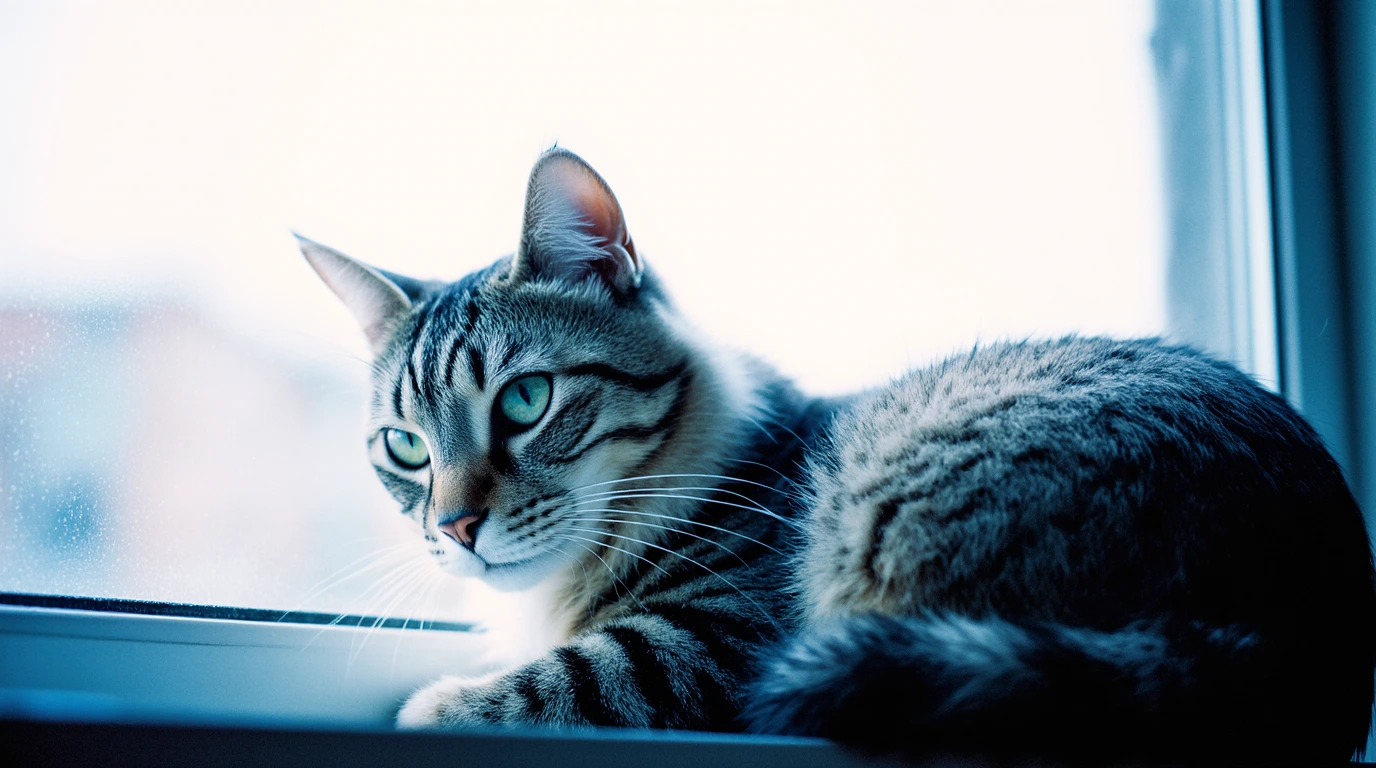Introduction:
What’s Really Going On in Your Cat’s Head?
Ever caught your cat silently staring at a blank wall — not twitching, not blinking, just being? If you’ve wondered what’s happening behind those unblinking eyes, you’re not alone. The way cats think has long fascinated and baffled humans. Unlike dogs, whose emotions and intentions are often transparent, cats operate on a different cognitive wavelength — one that’s quieter, more deliberate, and surprisingly complex.
Understanding cat thinking isn’t just some quirky curiosity for pet lovers. It’s the key to decoding their behaviors, deepening your bond, and even spotting early signs of stress or illness. When you grasp how cats process the world — how they remember, react, and even “plan” — your relationship with them changes. You begin to see the logic behind the aloofness, the pouncing, the mid-night zoomies.
In this article, we’ll unpack how cats think: from what science reveals about feline cognition, to the subtle emotional logic behind their behaviors. You’ll learn how to interpret their signals more accurately and create a more enriching environment that meets not just their physical needs, but their mental and emotional ones too.
Because let’s be honest — once you start looking at your cat not as a mystery, but as a thinking creature with its own internal logic, you’ll never see that quiet stare the same way again.
Table of Contents

Why Cat Thinking Matters
It’s easy to dismiss cats as inscrutable — aloof beings who sleep all day and occasionally grace us with their attention. But here’s the twist: that very aloofness is a product of highly evolved cognition. Cat thinking isn’t just about instinct — it’s about interpretation, memory, and decision-making. Understanding it isn’t a luxury for pet nerds; it’s a practical necessity for any cat owner who wants to connect more deeply with their feline companion.cat thinking.
For starters, cats don’t act randomly. Every tail flick, stare, or silent retreat is loaded with context. They’re constantly assessing their environment — measuring threats, predicting outcomes, and calculating effort vs. reward. This mental filtering system is why they ignore the flashy toy but obsess over a crinkly receipt on the floor. It’s not about being weird. It’s about what matters to them.cat thinking.
If you’ve ever tried to train a cat, you’ve already seen how thinking affects behavior. Unlike dogs, cats need to see value in an action before they repeat it. That’s not stubbornness — that’s selective decision-making rooted in motivation and memory. Understanding that framework doesn’t just make training easier; it makes your expectations more realistic.cat thinking.
And then there’s emotional health. Cats can get bored. Anxious. Overstimulated. They can even ruminate in ways we don’t fully understand yet. Recognizing that your cat thinks, and doesn’t just react, opens the door to better care — from choosing the right toys to spotting early signs of cognitive decline.cat thinking.
Bottom line? The more we acknowledge cats as thinking beings, the more we can meet them where they are — not just physically, but psychologically.cat thinking.
FAQ – Why should I care how my cat thinks?
A: Because it directly affects your relationship. Cats communicate through behavior. When you understand their thought patterns, you can interpret what they’re trying to tell you — whether it’s “I’m stressed,” “I’m curious,” or “Back off.” It’s the difference between coexisting and truly connecting.cat thinking.
The Science of Feline Cognition cat thinking.
Before we decode the mystery of cat thinking, we need to understand what’s actually going on inside a cat’s brain. While science hasn’t cracked every aspect of feline cognition, we know more than ever about how cats perceive, remember, and respond to the world — and it’s a lot more nuanced than “sleep, eat, ignore.”
Cat Brain 101: A Surprisingly Efficient Machine
Let’s get anatomical for a second — not too deep, just enough to appreciate the design. A cat’s brain is about the size of a walnut, yet it’s packed with over 250 million neurons in the cerebral cortex (vs. around 160 million in dogs). That’s the part responsible for decision-making, memory, and problem-solving. In other words: the “thinking” part.
What’s fascinating is the structure. The feline brain shares about 90% of its structure with the human brain. That doesn’t mean cats are tiny, furry philosophers — but it does suggest they’re capable of complex emotional processing, associative learning, and even observational strategy.cat thinking.
Cognitive Tools: How Cats Use Their Minds cat thinking.
Cats use a blend of instinct and learned behavior. While their survival strategies are hardwired, they also learn through experience — both good and bad. Ever notice your cat avoids a certain room after a loud noise? That’s spatial memory at work. Did they “accidentally” learn to open the cabinet where treats are kept? That’s problem-solving, not coincidence.cat thinking.
Key areas of cognitive strength in cats:
- Memory recall — especially for places and routines
- Observation-based learning — watching and mimicking behaviors
- Emotional mapping — associating people or events with safety or danger
- Sensory integration — using whiskers, smell, and sight to evaluate new environments
Their thinking is less about verbal logic and more about pattern recognition, timing, and spatial judgment.
FAQ – Are cats smarter than dogs? cat thinking.
A: It depends on how you define “smart.” Dogs may excel at social intelligence and command following, but cats often outperform in memory, independence, and environmental problem-solving. Cats think more silently — but that doesn’t mean they’re not processing deeply.cat thinking.
Common Cat Behaviors: What They Reveal About Thinking

Cats rarely do anything by accident. From the outside, their actions might look random — sitting in the sink, batting at dust particles, bolting down the hallway at 3 a.m. But underneath these quirks is a surprisingly thoughtful system. These aren’t just behaviors — they’re expressions of how cats process the world. To understand cat thinking, we need to read these signals as mental outputs, not just instincts.cat thinking.
Staring into Space: Deep in Thought, or Just Bored? cat thinking.
We’ve all seen it: your cat is perched quietly, staring at… nothing. But that gaze isn’t empty. Cats have hyper-attuned senses and tend to track sounds, vibrations, or subtle movements we can’t detect. They may be watching a speck of dust float, or even anticipating a prey-like pattern they’ve seen before. This kind of still observation is a form of environmental mapping — like mental rehearsal.
Some experts believe cats also “replay” scenarios — processing past interactions, rewards, or threats — especially in calm states. Think of it as feline reflection.
Kneading, Purring & Meowing: Emotional Language
Kneading isn’t just a leftover kitten reflex — it’s also a form of comfort-seeking and territory marking. Purring? That’s not always a “happy” sound. Cats also purr when stressed or in pain. They’re communicating complex emotional states — often unconsciously — shaped by memory and need.
Even vocalizations are more calculated than they seem. Cats don’t meow much to other cats. They meow to us. In fact, they often develop unique “meow vocabularies” for different people — adapting their sounds based on what gets results. That’s cognitive feedback in action.
Play & Hunting: Strategic Thinking in Disguise cat thinking.
Ever seen your cat stalk a toy for 20 minutes before pouncing? That’s not aimless play. It’s predatory strategy. Cats simulate real-world hunting, breaking it into phases: stalk, freeze, chase, pounce. They learn from failed attempts and adjust their timing or approach next time.
Even solo play (like flipping a pen off the table) is partly mental — testing reactions, physics, and cause-effect patterns. Play isn’t just fun. It’s how cats train their minds to navigate complexity.
FAQ – Why does my cat suddenly run around like crazy?
A: That “midnight zoomie” behavior is often a release of pent-up energy or stress. But cognitively, it may also be tied to ancestral routines — dusk is prime hunting time. Zooming can be a burst of instinctive thinking: “I need to chase, now.” It’s part thought, part biology, part legacy.
How to Read Your Cat’s Mind (Without Being a Mind Reader)
Trying to figure out what your cat is thinking can feel like decoding a language with no dictionary. But cats do communicate — constantly. You just have to learn their subtle vocabulary. Understanding cat thinking starts by reading the signs: body language, vocal tone, context. Once you piece these together, patterns emerge — and suddenly, your cat doesn’t seem so mysterious.
Body Language: The Silent Dictionary
Cats are master non-verbal communicators. Their ears, eyes, tails, and even whiskers serve as indicators of thought and mood. For example:
- Ears swiveling → Your cat’s tracking sound or deciding whether something is worth investigating.
- Dilated pupils → Heightened arousal; could be excitement or fear.
- Tail swish → Not always anger. It can signal indecision, stimulation, or internal conflict.
What looks like “doing nothing” is often a cat gathering sensory input and weighing options. Think of it as mental multitasking through stillness.
Vocalizations: Not Just Noise
Cats don’t waste words — or sounds. Over time, they craft specific tones for specific outcomes. A short, high-pitched meow might mean, “Feed me.” A long, low moan could mean, “This situation is sketchy.” Trills, chirps, and chatters show up when they’re excited or trying to lead you somewhere.
These sounds aren’t arbitrary — they’re results of trial, memory, and adjustment. Your cat has trained you, based on how you respond.
Context Clues: The Invisible Layer
One of the most overlooked elements of feline communication is context. Is it morning? Have you just come home? Is a guest in the house? Cats don’t think in isolation — their behaviors are often triggered by patterns or anticipated outcomes. Learning to “read the room” from your cat’s perspective helps you interpret their actions more accurately.
For example:
- Your cat sits by the door after you pick up your keys = anticipatory behavior.
- They meow more after a vet visit = stress recall.
It’s not guesswork. It’s associative reasoning — and your cat is quietly doing it all the time.
FAQ – How do I know if my cat is trying to tell me something?
A: They probably are — always. The key is to observe changes in behavior, not just the behavior itself. If your cat normally ignores you but starts following you around, they’re thinking differently. It could mean curiosity, stress, or seeking connection. Consistency is baseline; change is message.

Boosting Cognitive Engagement: Helping Your Cat Think Better
Cats don’t just want to lounge around all day — at least not mentally. Their minds are built for exploration, pattern-seeking, and problem-solving. In the wild, cats spend much of their day figuring out where to hunt, how to hide, when to move. Take that structure away, and you risk boredom, stress, and even depression. Helping your cat think more actively is one of the most overlooked (and impactful) parts of feline care.
Puzzle Toys: Workouts for the Brain
Forget bells and feathers for a moment. Puzzle feeders, treat balls, and interactive toys are like Sudoku for your cat. These tools force them to strategize: “How do I get that treat?” It’s not just about food — it’s about tapping into their planning brain.
Options to try:
- Food mazes or slow feeders
- Treat-dispensing balls that require batting and rolling
- Hide-and-seek games using toys under towels or inside boxes
Start simple and ramp up the complexity. Watch how your cat adapts — they’re likely thinking harder than you realize.
Clicker Training: Yes, You Can Teach a Cat
Clicker training might sound like a dog thing, but cats thrive with this kind of positive reinforcement learning. The basic structure:
- Click = you did something right
- Treat = reinforcement
- Repetition = habit + cognition
You’re not just teaching “sit” — you’re training the sequence of action and reward, which is all about cognitive mapping. This boosts memory, focus, and confidence.
Environmental Enrichment: Space That Stimulates
Cognition isn’t just about activities — it’s about the environment. Boredom often starts with sameness. Try:
- Rotating toys weekly to keep novelty alive
- Installing vertical spaces: cat trees, shelves, wall bridges
- Creating “viewing zones” near windows with bird feeders outside
Even background noise (like nature sounds or a bubbling aquarium) can stimulate a cat’s auditory curiosity. Enrichment isn’t about chaos — it’s about options.
FAQ – How do I know if my cat is mentally bored?
A: Signs of cognitive boredom include over-grooming, excessive sleeping, restlessness, or strange repetitive behaviors (like pacing or shadow-chasing). If your cat seems “checked out” or unusually clingy, it may not be mood — it might be mental under-stimulation.
Dealing with Problematic Thinking Patterns in Cats
Not all thinking leads to peace. Just like humans, cats can spiral into unhelpful patterns — obsessing, stressing, withdrawing, or reacting disproportionately. We often mistake these shifts as mood swings or “bad behavior,” but beneath the surface, there’s usually a cognitive imbalance: something in their environment or inner world is looping the wrong way.
Understanding these patterns through the lens of cat thinking helps you intervene earlier and more effectively — not just to fix a problem, but to support your cat’s mental health.
Anxiety, Rumination & the Cat Brain Loop
Cats may not “worry” like we do, but they do associate, predict, and recall — sometimes obsessively. If a past experience (like a vet trip) was traumatic, they might begin to avoid carriers entirely. If they’ve been overstimulated in a certain room, they might stare at the doorway and refuse to enter. These aren’t random responses; they’re pattern-based avoidance behaviors driven by mental associations.
Common signs:
- Hiding for extended periods
- Excessive startle response
- Meowing when alone
- Hyper-vigilance (pacing, tail flicking, ears scanning)
These are not quirks — they’re the brain stuck in a loop.
Obsession & Repetitive Behaviors
Does your cat lick one spot obsessively? Chase invisible things? Chew non-food items? These can be signs of compulsive thinking — where stimulation has become too narrow or too repetitive. It’s often a side effect of boredom, under-enrichment, or stress. Some cats even “invent” repetitive rituals to cope with mental underload.
What helps:
- Disrupt routine subtly (change toy types, adjust feeding games)
- Introduce “surprise novelty” (like a new scent or object)
- Offer soothing stimulation: low lighting, calming pheromone diffusers
When to Call the Vet (Seriously)
If behavior shifts are sharp, constant, or intensifying, it’s time to consult a vet. Cognitive symptoms can signal:
- Pain or neurological issues
- Vision/hearing loss
- Early feline dementia
- Compulsive disorders
It’s not just behavioral. It’s brain health, and it deserves clinical attention.
FAQ – Can cats get mental health issues like humans?
A: Yes — not in the exact same way, but cats can experience anxiety, depression, obsessive-compulsive behaviors, and even cognitive decline as they age. Their thought loops may not involve “language,” but their emotional and behavioral patterns reflect real mental strain.
FAQs on Cat Thinking
To really get a grip on how cats think, sometimes you just need clear, honest answers to the weirdest, most common questions. Below are some of the most frequently asked questions about cat thinking — the kind of stuff that keeps cat parents guessing (and Googling at 2 a.m.).
Do cats think about us?
Yes — and not just as food dispensers. Cats form emotional bonds with people, and they mentally track your routines, moods, and responses. They may not think in full sentences, but they create mental associations like “safe,” “annoying,” “comforting,” or “play partner.” If you change your schedule, tone, or even your cologne, your cat notices — and adjusts their behavior based on their internal model of you.
Can cats plot revenge?
Nope — not in the human sense. Cats aren’t vindictive thinkers. If they pee on your clothes, it’s not “payback.” It’s usually stress, territory confusion, or a disrupted routine. That said, cats do remember negative associations and might avoid you (or certain objects) as a protective response. It can feel like grudge-holding, but it’s really behavioral memory at work.
Are cats aware of time?
Not in a clock sense, but yes — cats are extremely pattern- and rhythm-driven. They know when you usually get home, when breakfast happens, and when the sun hits the perfect nap spot. Their internal clocks are guided by light, temperature, hunger, and routine. Break those patterns, and you’ll see behavioral “surprises” — meowing at odd hours, pacing, or acting confused.
Do cats dream or imagine?
They absolutely dream — REM sleep is well-documented in cats, often accompanied by twitching paws and ears. As for imagination? It’s hard to prove. But their complex play and planning behaviors suggest they can simulate scenarios internally: “If I hide here, the toy might go there.” That’s not fantasy, exactly — it’s predictive mental modeling, which is a big part of thinking.

